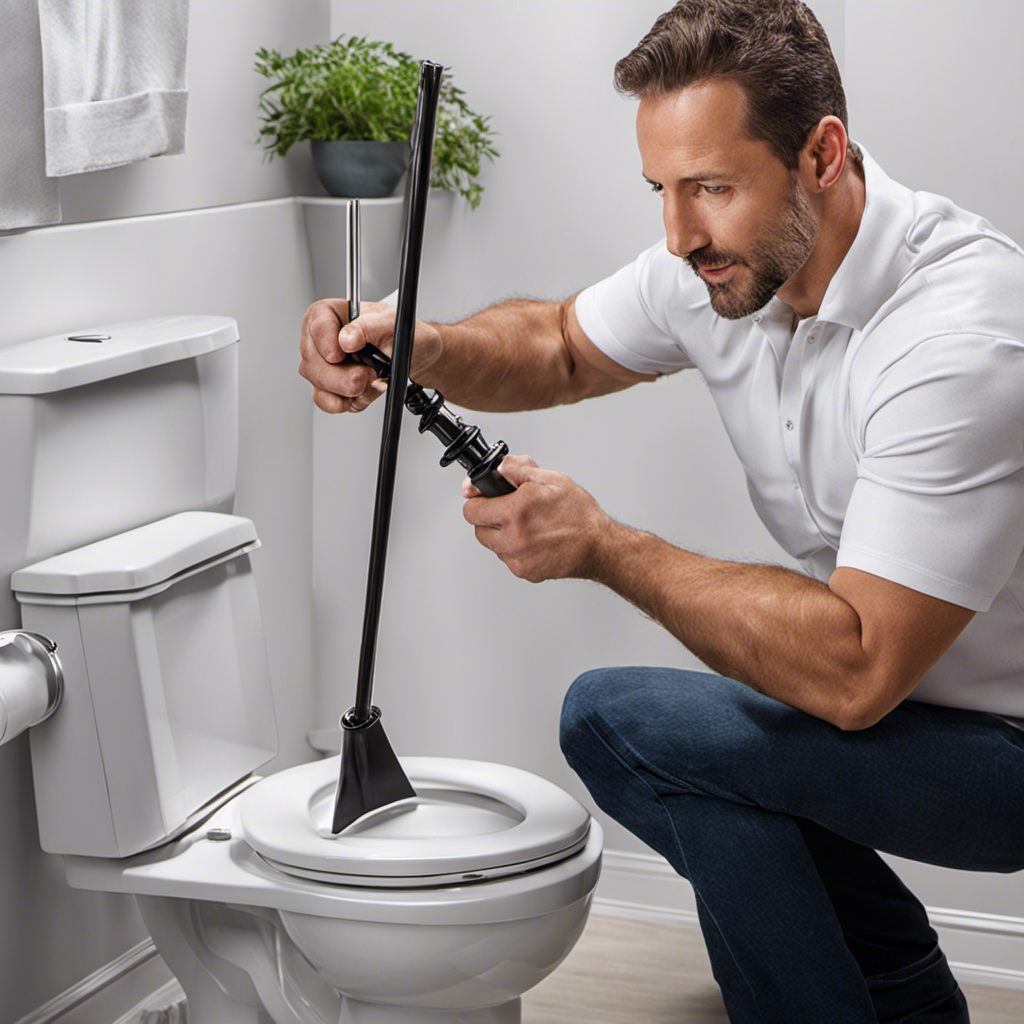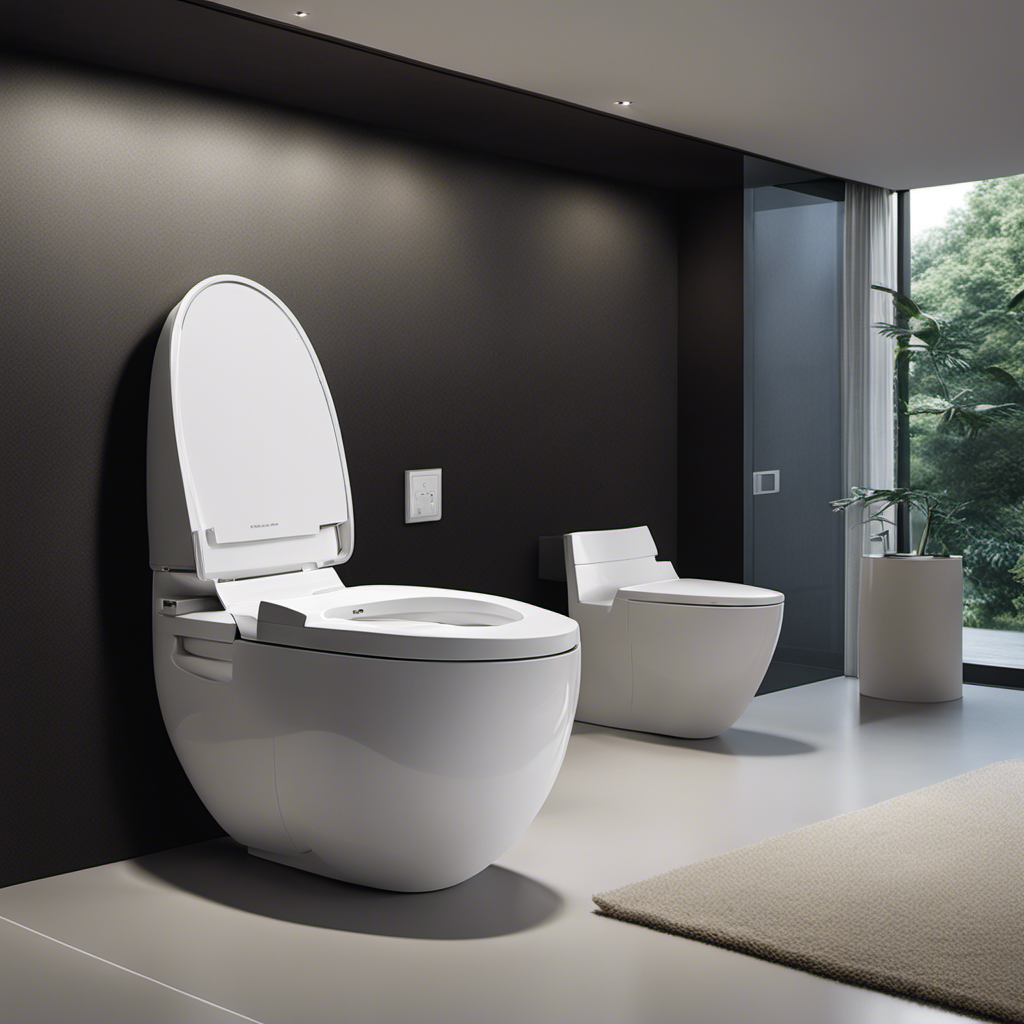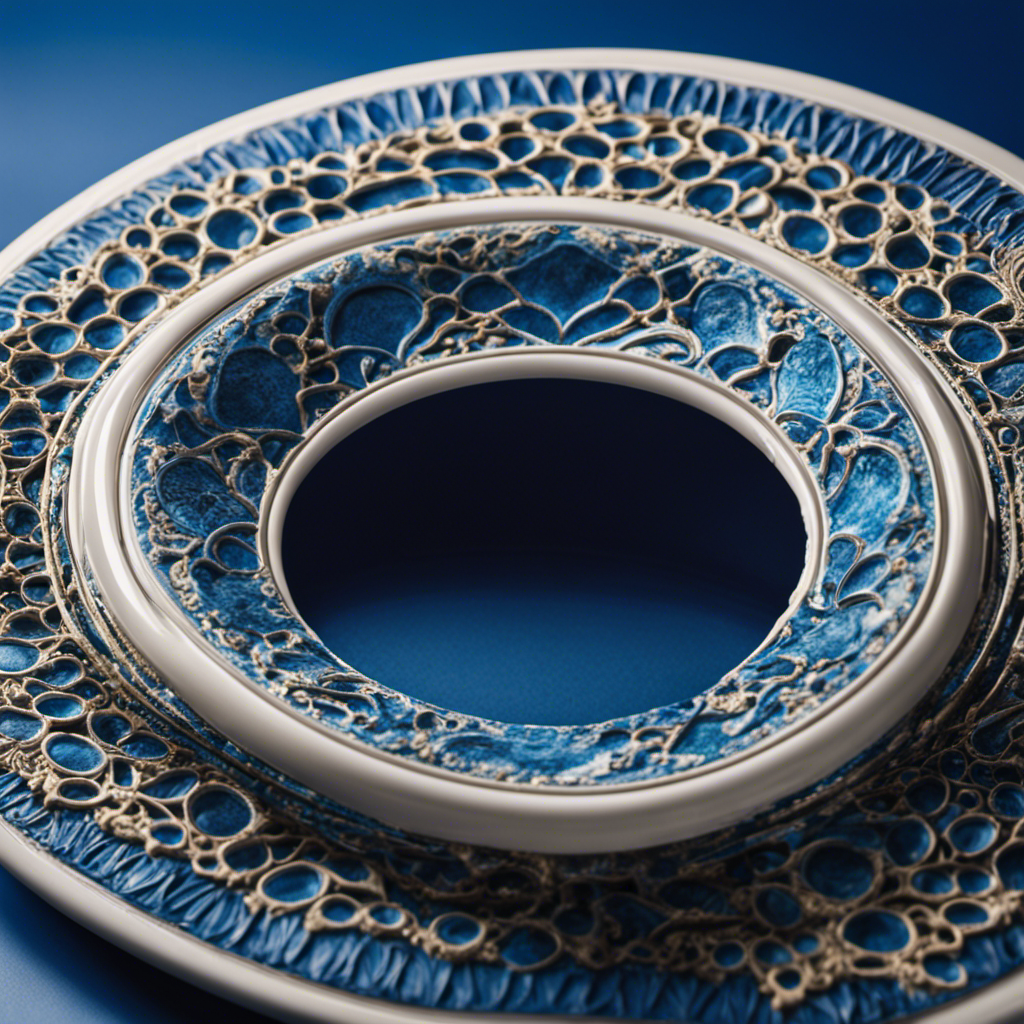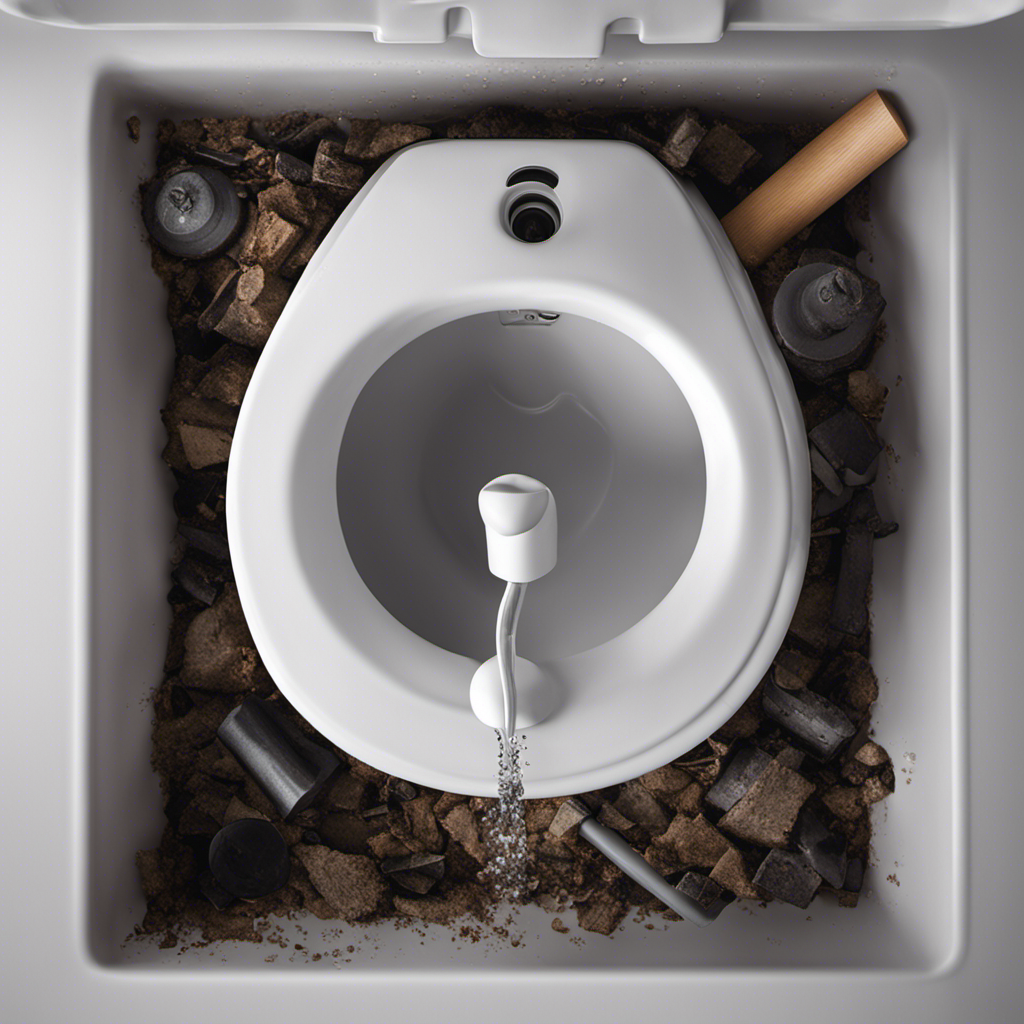Are you tired of dealing with stubborn clogs in your toilet? Look no further than the trusty toilet auger! This handy tool, also known as a ‘snake,’ can help you effortlessly unclog your toilet and restore the flow of water.
In this article, we will explore the different types of toilet augers, how they work, and the benefits of using one.
Get ready to say goodbye to those pesky clogs and hello to a smoothly functioning toilet!
Key Takeaways
- Toilet augers are specifically designed for unclogging toilets and are more effective than plungers.
- They have a long, flexible cable that can reach deep into the toilet drain to break apart stubborn clogs.
- Toilet augers minimize the risk of messy splashback during the unclogging process.
- If a plunger is not effective or if there are recurring clogs, a toilet auger can effectively clear stubborn clogs.
Types of Toilet Augers
There are two main types of toilet augers: the closet auger and the drum auger. Each type has its own advantages, making them suitable for different situations.
The closet auger, also known as a toilet auger or water closet auger, is specifically designed for clearing clogs in toilets. It features a long, flexible cable with a curved end that allows it to navigate through the trapway of the toilet bowl.
The drum auger, on the other hand, is more versatile and can be used for clearing clogs in sinks, tubs, and other drains. It consists of a coiled cable housed in a drum-like container, which can be manually rotated to dislodge the blockage.
Now that we’ve covered the types of toilet augers, let’s explore how they work to unclog your toilet.
How Does a Toilet Auger Work
Toilet augers work by using a long, flexible cable to snake through the pipes and clear any clogs. The cable is inserted into the toilet bowl and extended into the drainpipe until it reaches the obstruction. Once the auger reaches the clog, it is rotated to break up the blockage and allow water to flow freely.
When it comes to choosing the right toilet auger, there are a few factors to consider.
- Length: Opt for an auger with a length that can reach the clog without difficulty.
- Cable Material: Look for a toilet auger with a strong, durable cable that won’t break or kink easily.
- Handle Design: Consider the handle design for ease of use and comfort during operation.
Compared to a plunger, a toilet auger offers a more targeted and effective approach to clearing stubborn clogs. Its flexible cable can navigate through bends and traps in the pipes, ensuring a thorough removal of the blockage.
Benefits of Using a Toilet Auger
Using a toilet auger can provide a more effective and targeted approach to clearing stubborn clogs. When comparing a toilet auger to a plunger, there are distinct advantages to using an auger.
First and foremost, a toilet auger is specifically designed for unclogging toilets, whereas a plunger is a more general tool.
The auger’s long, flexible cable can reach deep into the toilet drain, allowing it to dislodge and remove obstructions that a plunger may not be able to reach.
The auger’s rotating head also helps to break apart and remove stubborn clogs more efficiently.
Another advantage of using a toilet auger is that it minimizes the risk of messy splashback, as the cable is inserted directly into the drain, preventing water from splashing out.
Overall, a toilet auger is a valuable tool for anyone dealing with persistent toilet clogs.
When to Use a Toilet Auger
If you’re experiencing a stubborn clog, it may be time to consider when it’s appropriate to use a toilet auger. A toilet auger, also known as a plumbing snake, is a tool specifically designed to tackle tough clogs in toilets.
Here are some signs that indicate it’s time to reach for the auger instead of a plunger:
-
Water rising in the bowl: If you notice the water level rising when you flush, it could be a sign of a clog deep in the pipes. A toilet auger can reach further down to dislodge the blockage.
-
Recurring clogs: If your toilet keeps getting clogged despite using a plunger, it may be an indication of a more serious problem. A toilet auger can effectively clear out stubborn clogs that a plunger can’t handle.
-
Foul odors: If you notice unpleasant smells coming from your toilet, it could be a sign of a clog that needs to be removed. A toilet auger can help eliminate the blockage and get rid of the odor.
Steps to Unclog a Toilet With a Toilet Auger
When faced with a stubborn clog, it’s important to follow these steps to effectively unclog the toilet using a toilet auger.
First, put on protective gloves and grab your toilet auger.
Insert the auger’s cable into the toilet bowl, ensuring it goes in straight and doesn’t scratch the porcelain.
Rotate the handle clockwise to push the cable through the clog. If you encounter resistance, try applying gentle pressure and then continue rotating.
Once the cable has reached the clog, give it a few more rotations to break it up.
Finally, retract the cable slowly while continuing to rotate the handle. Dispose of any debris that comes out.
By following these steps, you’ll be able to troubleshoot common toilet clog causes and effectively use a toilet auger to unclog your toilet.
Now, let’s dive into some tips for using a toilet auger safely.
Tips for Using a Toilet Auger Safely
When using a toilet auger, it is crucial to understand proper tool handling techniques to ensure both your safety and the effectiveness of the tool. By gripping the auger firmly but not too tightly, you can maintain control and prevent the tool from slipping or causing damage.
Additionally, it is important to be aware of potential injury risks, such as avoiding contact with sharp edges and keeping your hands and fingers clear of the rotating cable.
Proper Tool Handling
Proper tool handling includes using a toilet auger with caution to avoid any accidents. When it comes to toilet augers, there are a few things you need to keep in mind to ensure safe operation.
Here are three important tips for proper tool handling:
-
Proper tool storage: Always store your toilet auger in a safe and secure location, away from children and pets. This will help prevent any accidental injuries and ensure the longevity of your tool.
-
Avoiding excessive force: Applying too much force while using a toilet auger can cause damage to your plumbing system. Remember to use gentle, steady pressure and let the auger do the work.
-
Proper positioning: Make sure to position yourself correctly when using a toilet auger. This means standing securely and maintaining good balance to avoid any potential slips or falls.
By following these guidelines, you can minimize the risk of accidents and ensure a safe and efficient operation.
Now let’s move on to the next section about avoiding injury risks.
Avoiding Injury Risks
To minimize injury risks, make sure you are aware of your surroundings and take necessary precautions.
When it comes to avoiding injury risks while using a toilet auger, there are several common mistakes to be aware of. First, always ensure that the auger is properly secured before starting any operation. Inspect the equipment for any signs of wear or damage, as this can lead to accidents.
It is crucial to maintain a firm grip on the handle to prevent the auger from slipping or causing potential harm. Additionally, be cautious of your body positioning and avoid putting excessive force on the tool, as this can result in strain or injury.
Effective Blockage Removal
One effective way to remove blockages is by using a plunger. A plunger is a simple tool consisting of a rubber cup attached to a wooden or plastic handle. It works by creating suction and pressure to dislodge clogs in the toilet drain.
Here are three reasons why using a plunger is a reliable method for blockage removal:
- Plungers are affordable and readily available at most hardware stores.
- They are easy to use, requiring minimal effort and no special skills.
- Plungers are effective in clearing common toilet blockages caused by items like toilet paper, hair, or small objects.
Using a plunger is a practical first step to try when faced with a clogged toilet. However, if the blockage persists, a toilet auger may be necessary for more stubborn clogs.
Maintenance and Care for a Toilet Auger
Take care of your toilet auger by regularly cleaning it after each use. Proper maintenance and care are essential to ensure the longevity and effectiveness of your toilet auger.
After using the auger to clear a blockage, it is crucial to clean it thoroughly to remove any debris or waste that may have accumulated. Start by wiping down the handle and cable with a damp cloth to remove any residue.
Then, use a mild detergent and warm water solution to clean the auger’s cable and coil. Gently scrub the cable with a soft brush to dislodge any stubborn build-up. Rinse the cable thoroughly and allow it to dry completely before storing it.
Conclusion
In conclusion, a toilet auger is a highly effective tool for unclogging stubborn toilet blockages. By inserting the auger into the toilet bowl and rotating it, you can easily clear any debris that is causing the clog.
This tool is particularly useful in situations where a plunger fails to do the job. For instance, imagine a scenario where a family of four experiences a toilet clog right before a big dinner party. With the help of a toilet auger, they quickly resolve the issue and avoid any embarrassing mishaps during their event.
Remember to follow proper safety precautions and maintain your toilet auger for optimal performance.










